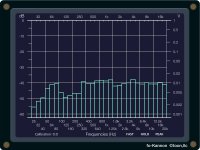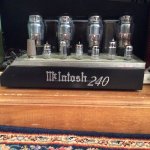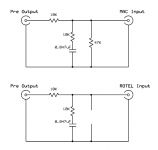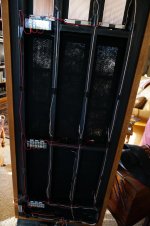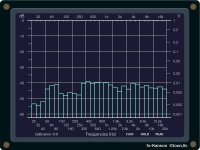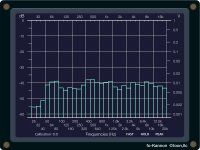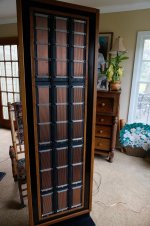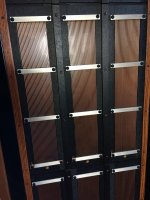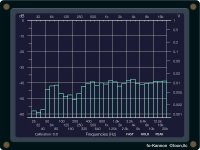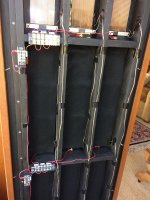Off hand, I can't think of any advantage in trying to use the 70V or 140V outputs....i've had the Mac for around 40 years... It has a Line Out Octal socket with a choice of 70v, 125 ohms or 140v, 600 ohms, which is considerably more than the speaker taps. Can these be used to feed the Dyna OPT's, or am I asking for big trouble, as in destroying the amp, the Dyna's, and possibly the speakers?
The output of the amp is still limited to 40W, you would just be shifting part of the impedance matching and step-up duty between the Mac’s and your ESL transformer.
I was actually thinking about this last night and was wondering (since the majority of your ESL impedance is >> 8 ohm) if your best option might be to try and use the 16 ohm output tap to feed your Dynaco transformers on their 4 ohm tap you are currently using with the Rotel. The output impedance of the Mac's 16 ohm tap is around 2 ohm, so the top end will likely droop a bit, but you can compensate for this by reducing the value of the resistor you have in series with the Dynaco transformer inputs. The output voltage would be ~ 25Vrms, so should sound more like a 100W than a 40W amp.
I am still playing around to see if there is a way to effectively fill in the mid-bass dip using a passive line-level EQ between preamp and power amp. It’s proving to be a bit tricky since the panels are so wide…the start of the roll off is not that far away from where the diaphragm resonance boost starting kicking in. It would be easy to EQ with an active line level circuit using just one or two opamps, but I’m not sure if that is something you would feel comfortable building. Alternatively, you could acquire a miniDSP unit that would allow you to tweak EQ in real time from your computer while listening. However, I do understand the desire to keep things as simple as possible.
https://www.minidsp.com/products/minidsp-in-a-box/minidsp-2x4
Hi Bolserst,
Thanks for all the info. I'll need a few bowls of Wheaties before I can bring the Mac in from the garage. The older I get, the heavier it gets. Will give the 16 ohm taps a try.
The minidsp sounds like a good option for me. I haven't bought any new audio equipment in a very long time, but I'm also thinking about purchasing a new digital preamp that will have room correction as an option. Hopefully that will help too. Only thing is, it does not have tone controls, so I could be back to polite bass again. Don't know. We'll see. Really appreciate all you've done.
Thanks for all the info. I'll need a few bowls of Wheaties before I can bring the Mac in from the garage. The older I get, the heavier it gets. Will give the 16 ohm taps a try.
The minidsp sounds like a good option for me. I haven't bought any new audio equipment in a very long time, but I'm also thinking about purchasing a new digital preamp that will have room correction as an option. Hopefully that will help too. Only thing is, it does not have tone controls, so I could be back to polite bass again. Don't know. We'll see. Really appreciate all you've done.
Connected the Mac up this morning. Jeepers, that thing is heavy(56 lbs). It's not a shiny one, but is excellent sounding, definitely different than the Rotel. There's more bottom end to it, maybe a shade less tight that the Rotel, but I think I prefer its warmth. Mid and highs are what the Macs are famous for. So far the volume has been more than enough for my musical tastes, and surprisingly the highs do not sound diminished at all, actually a tad brighter. Perhaps this type of ESL does not follow the expected norm?
Took some measurements with the speaker and mic in the exact same position as before; bass is turned up half way. It does show more bottom end in the 50-60hz range, however it seems like it's syphoning from the 100 hz range to accomplish this added bass. Strange since this is the frequency where the tone control kicks in. Except for the wider dip, the over all response is the smoothest the speakers have ever measured. Is this a sign of better impedance matching? Looking forward to a miniDSP or preamp in the future.
Still having a great time tinkering.
Took some measurements with the speaker and mic in the exact same position as before; bass is turned up half way. It does show more bottom end in the 50-60hz range, however it seems like it's syphoning from the 100 hz range to accomplish this added bass. Strange since this is the frequency where the tone control kicks in. Except for the wider dip, the over all response is the smoothest the speakers have ever measured. Is this a sign of better impedance matching? Looking forward to a miniDSP or preamp in the future.
Still having a great time tinkering.
Attachments
The lack of HF roll off was certainly not what I had expected. This indicates that the capacitive load in the top octaves is modifying the phase of the feedback loop in the amp resulting in a mild amount of boost. I have seen this behavior with other tube amps, but for some reason I thought I had read that Mac’s were immune to response variations from capacitive loads.Connected the Mac up this morning….There's more bottom end to it, maybe a shade less tight that the Rotel, but I think I prefer its warmth. Mid and highs are what the Macs are famous for. So far the volume has been more than enough for my musical tastes, and surprisingly the highs do not sound diminished at all, actually a tad brighter. Perhaps this type of ESL does not follow the expected norm?
The overall smoother response thru the midrange and highs is a happy coincidence of the output impedance of the amp modifying the response in an agreeable manner. As far as the slightly more prominent dip, this may be where the response modification is not as “happy”. I can only speculate…would need to measure the electrical response at the input of the transformers to know for sure.Took some measurements with the speaker and mic in the exact same position as before; bass is turned up half way. It does show more bottom end in the 50-60hz range, however it seems like it's syphoning from the 100 hz range to accomplish this added bass. Strange since this is the frequency where the tone control kicks in. Except for the wider dip, the over all response is the smoothest the speakers have ever measured. Is this a sign of better impedance matching?
Good to hear you’re still having funStill having a great time tinkering.
I think you will enjoy the capabilities that DSP can provide if you decide to take the plunge.
In the meantime, if you want to experiment with a passive shelving filter, the attached schematic should give you a bass equalization similar to what you currently get with your bass control partially turned up.
Attachments
Finally got around to installing 10meg resistors for each of the ten panels that Geraldfryjr recommended.(attachment 1) Didn't think it would make much of a difference, but it did. They are louder and have a slightly fuller, richer sound. The other night I was listening to some female choral pieces that sounded so beautiful, I was afraid to leave my chair for fear(as with bolserst) that the magic would disappear on my return. Eventually I had to make a visit to the 'library'. When I sat back down in my chair I was happy to find it was not the work of a 'sonic elf' I was hearing, but an actual improvement in sound...ever so slight but there. Thank you jer.
Put together the shelving circuit that boserst designed. Works very well. Ive been fiddling with trying to integrate a subwoofer for some of the missing lower notes, but since I have the bass increased and the signal is split to the amp and the sub, the lows were just too overpowering. But now with the shelf, the amp only receives the boost and the sub sounds better. Not ideal but helpful with a few recordings. Thank you Bolserst
The first graph is of the speaker with the shelving circuit and the tone controls set to flat. It's very similar to the tone increase graphs, maybe a tad less smooth. This and the other measurements have been made with the ESL placed in the center of the living room. The second graph is the speaker in its actual listening position, which seems to lessen the dip a bit. For some reason the dip was even less when the Khorns were in the corners, but I'm not willing to bring them back in. DSP is in the future.
Put together the shelving circuit that boserst designed. Works very well. Ive been fiddling with trying to integrate a subwoofer for some of the missing lower notes, but since I have the bass increased and the signal is split to the amp and the sub, the lows were just too overpowering. But now with the shelf, the amp only receives the boost and the sub sounds better. Not ideal but helpful with a few recordings. Thank you Bolserst
The first graph is of the speaker with the shelving circuit and the tone controls set to flat. It's very similar to the tone increase graphs, maybe a tad less smooth. This and the other measurements have been made with the ESL placed in the center of the living room. The second graph is the speaker in its actual listening position, which seems to lessen the dip a bit. For some reason the dip was even less when the Khorns were in the corners, but I'm not willing to bring them back in. DSP is in the future.
Attachments
Thought I'd give an update on a few modifications during the last several months. It was an unusually wet winter, so what better project to work on in the garage than to fiddle with the speakers.
1. As mentioned previously, I was never happy with how the bottom horizontal panels seemed out of place with the other vertical ones. Decided to build new wood frame assemblies that would accommodate three vertical seven inch panels. They are, at least to me, more aesthetically pleasing. I didn't think there would be any difference in sound quality, and there wasn't-measurement wise or listening wise. Also for aesthetics, the plastic tabs holding the panels to the frame were replaced with 1/8"x3/4" oak wood strips, with the outside strips stained to match the oak frame. As an added bonus, the strips hold the panels more evenly and securely, enabling me to increase the voltage to the EMCO module from 8.5v to 10v. Should correspond to a bias voltage of around 2500-2700v.
2. After learning a little more on charge migration and its impact on non linear distortion, I upped the bias resistance from 10 meg to 30 meg. Sometimes I think the music sounds cleaner, but I honestly don't know for sure. May try 50 meg in the future.
3. In another thread I commented that although the speakers were very transparent and detailed, I thought maybe some improvements could be made. The simplest experiment(actually not that simple) would be to lower the mass of the diaphragm on a few of the panels. The 6um mylar was replace with 3um on the top two center panels. Originally, I was just going to disassemble the existing ABS frames, however I could not get them apart without distorting the plastic. That Scor-tape is really holding well; also very little if any 'creep' into the open diaphragm. Had to build four new panels.
Thought about trying Licron spray on the mylar, but then worried that there might be compatibility issues with the the other low resistance graphite ones. So coated with the tried an true graphite. Boy, was that ever frustrating. The slightest speck of dust would develop into hole or worse, a complete tear. It took several attempts but I was finally able to coat enough useable mylar to cover four panels.
I know that some enthusiasts do not think there should be much of a performance difference between 6um and 3um, but to my ears there was a definite improvement in detail. Not a 'golly jeepers' moment, but a perceptible and pleasing improvement. Kinda like slightly increasing the dimmer switch on a light fixture. Except for the actual piano in our living room, I've never heard a more realistic sounding piano coming from any other speaker I have owned. In my case this was a worthwhile experiment. On the other hand, perhaps those of you who have higher turns ratios(>100:1) and/or higher bias voltages(>4000) may have similar results with 6um? Interesting
4. Splurged(at least for me) and bought one of those combo Preamp/DAC/Streamer devices. Another nice improvement in sound. I have now discovered the wonderful marvelous world of streaming music. I'm finding recordings I haven't heard in decades. Even though the service I'm using(Spotify) is not lossless, the sound is still quite spectacular, at times the best source I've ever heard. There's even a simple 5 band equalizer that helps with some of my ESL's phase cancellation. Plus the preamp combo is supposed to have a future firmware upgrade that will enable room correction, so that should help too. Really enjoying the sound.
Looking forward to any future improvements.
Bondsan
Attachments: 1-new panel assembly, 2-wood strips, 3-latest sweep
1. As mentioned previously, I was never happy with how the bottom horizontal panels seemed out of place with the other vertical ones. Decided to build new wood frame assemblies that would accommodate three vertical seven inch panels. They are, at least to me, more aesthetically pleasing. I didn't think there would be any difference in sound quality, and there wasn't-measurement wise or listening wise. Also for aesthetics, the plastic tabs holding the panels to the frame were replaced with 1/8"x3/4" oak wood strips, with the outside strips stained to match the oak frame. As an added bonus, the strips hold the panels more evenly and securely, enabling me to increase the voltage to the EMCO module from 8.5v to 10v. Should correspond to a bias voltage of around 2500-2700v.
2. After learning a little more on charge migration and its impact on non linear distortion, I upped the bias resistance from 10 meg to 30 meg. Sometimes I think the music sounds cleaner, but I honestly don't know for sure. May try 50 meg in the future.
3. In another thread I commented that although the speakers were very transparent and detailed, I thought maybe some improvements could be made. The simplest experiment(actually not that simple) would be to lower the mass of the diaphragm on a few of the panels. The 6um mylar was replace with 3um on the top two center panels. Originally, I was just going to disassemble the existing ABS frames, however I could not get them apart without distorting the plastic. That Scor-tape is really holding well; also very little if any 'creep' into the open diaphragm. Had to build four new panels.
Thought about trying Licron spray on the mylar, but then worried that there might be compatibility issues with the the other low resistance graphite ones. So coated with the tried an true graphite. Boy, was that ever frustrating. The slightest speck of dust would develop into hole or worse, a complete tear. It took several attempts but I was finally able to coat enough useable mylar to cover four panels.
I know that some enthusiasts do not think there should be much of a performance difference between 6um and 3um, but to my ears there was a definite improvement in detail. Not a 'golly jeepers' moment, but a perceptible and pleasing improvement. Kinda like slightly increasing the dimmer switch on a light fixture. Except for the actual piano in our living room, I've never heard a more realistic sounding piano coming from any other speaker I have owned. In my case this was a worthwhile experiment. On the other hand, perhaps those of you who have higher turns ratios(>100:1) and/or higher bias voltages(>4000) may have similar results with 6um? Interesting
4. Splurged(at least for me) and bought one of those combo Preamp/DAC/Streamer devices. Another nice improvement in sound. I have now discovered the wonderful marvelous world of streaming music. I'm finding recordings I haven't heard in decades. Even though the service I'm using(Spotify) is not lossless, the sound is still quite spectacular, at times the best source I've ever heard. There's even a simple 5 band equalizer that helps with some of my ESL's phase cancellation. Plus the preamp combo is supposed to have a future firmware upgrade that will enable room correction, so that should help too. Really enjoying the sound.
Looking forward to any future improvements.
Bondsan
Attachments: 1-new panel assembly, 2-wood strips, 3-latest sweep
Attachments
Thanks for your info....
I have found in over 30 years ...like jim Strickland of Acoustat , big higher ohm res. like his 500meg... at the end of his bias string, gives vary good sound...If like Acoustat panels.... your panel can hold a charge for a long time...an play for over 1-2 min after you unplug the bias feed?
Martin logan uses 60meg on all there panels....why?....there panels can not hold a charge for as long as the Acoustat panels..... drive them hard you can hear them begain to use up the bias if the res is to high... cant keep them charged... sound quality changes...I have put 500meg on the logan panels bias feed... at lower output it sounds great.
You may go as high as...60- 100meg...what I hear is just less bias noise from higher bias res...that in all cases well sound better too most..
All just one mans finding
I have found in over 30 years ...like jim Strickland of Acoustat , big higher ohm res. like his 500meg... at the end of his bias string, gives vary good sound...If like Acoustat panels.... your panel can hold a charge for a long time...an play for over 1-2 min after you unplug the bias feed?
Martin logan uses 60meg on all there panels....why?....there panels can not hold a charge for as long as the Acoustat panels..... drive them hard you can hear them begain to use up the bias if the res is to high... cant keep them charged... sound quality changes...I have put 500meg on the logan panels bias feed... at lower output it sounds great.
You may go as high as...60- 100meg...what I hear is just less bias noise from higher bias res...that in all cases well sound better too most..
All just one mans finding
A couple more changes:
1. Since I perceived a slight resolution improvement with the 3um mylar, thought I'd replace a few more panels with the thinner diaphragm to see if there would be even more detail. On the middle row panels, the two outer group 2 panels were 'lightened up'. Now whenever time, effort, and/or money is involved in a modification, you're wanting, waiting, expecting some sort of a change...hoping for an additional improvement in transparency. I listened to all my standards; Sinatra, jazz, sopranos, tenors, orchestral and choral works, piano, etc. And after several listening sessions I can confidently conclude that my ears could not hear one iota of a difference, let alone an improvement. On a few of the sessions, even after a second glass of a Marlborough Sauvignon Blanc there still was a lack of change. Very disappointing(not the wine). But that's part of the fun in experimenting. I should comment that I'd run out of ABS plastic and had to make a run down to the plastic store. I asked if there was something that was stronger than ABS but easier to work with than FR4. They recommended black polycarbonate. I found this material to be stronger but no stiffer than ABS, which was the characteristic I was actually looking for. The PC was also a magnet for dust particles so I do not recommend its use as a frame material.
2. I upped the individual panel resistors from 10 to 20 meg, with another 20 meg in series feeding each horizontal row of three panels(see below). Coming directly off the bias supply is another 40 meg, for a total of 80 meg.
Once again I'm not sure if I can hear any change in the sound. Loudness wise, there is no difference. My ears struggle to hear any frequencies beyond 10K, so that might be a limitation that affects my listening in this case. I suspect that younger ears probably could discern changes much easier.
But what I do notice is a change in the presentation of the music...the soundstage seems broader with more depth and the instruments having more focus. I already thought that the speakers had a great image, but this is a pleasant and welcomed improvement. I haven't the foggiest idea why this would be. Even if it's only my sonic elf friend deciding to stay a while it's ok, I'll take the perception.
Forgot to mention in the previous post that the wood strips holding down the panels has helped the tautness of the bass. I've also removed the subwoofer, preferring the music presentation coming all from just the stats.
Thanks again to all for the help and suggestions enabling me to own a top notch set of loudspeakers
1. Since I perceived a slight resolution improvement with the 3um mylar, thought I'd replace a few more panels with the thinner diaphragm to see if there would be even more detail. On the middle row panels, the two outer group 2 panels were 'lightened up'. Now whenever time, effort, and/or money is involved in a modification, you're wanting, waiting, expecting some sort of a change...hoping for an additional improvement in transparency. I listened to all my standards; Sinatra, jazz, sopranos, tenors, orchestral and choral works, piano, etc. And after several listening sessions I can confidently conclude that my ears could not hear one iota of a difference, let alone an improvement. On a few of the sessions, even after a second glass of a Marlborough Sauvignon Blanc there still was a lack of change. Very disappointing(not the wine). But that's part of the fun in experimenting. I should comment that I'd run out of ABS plastic and had to make a run down to the plastic store. I asked if there was something that was stronger than ABS but easier to work with than FR4. They recommended black polycarbonate. I found this material to be stronger but no stiffer than ABS, which was the characteristic I was actually looking for. The PC was also a magnet for dust particles so I do not recommend its use as a frame material.
2. I upped the individual panel resistors from 10 to 20 meg, with another 20 meg in series feeding each horizontal row of three panels(see below). Coming directly off the bias supply is another 40 meg, for a total of 80 meg.
Once again I'm not sure if I can hear any change in the sound. Loudness wise, there is no difference. My ears struggle to hear any frequencies beyond 10K, so that might be a limitation that affects my listening in this case. I suspect that younger ears probably could discern changes much easier.
But what I do notice is a change in the presentation of the music...the soundstage seems broader with more depth and the instruments having more focus. I already thought that the speakers had a great image, but this is a pleasant and welcomed improvement. I haven't the foggiest idea why this would be. Even if it's only my sonic elf friend deciding to stay a while it's ok, I'll take the perception.
Forgot to mention in the previous post that the wood strips holding down the panels has helped the tautness of the bass. I've also removed the subwoofer, preferring the music presentation coming all from just the stats.
Thanks again to all for the help and suggestions enabling me to own a top notch set of loudspeakers
Attachments
- Status
- This old topic is closed. If you want to reopen this topic, contact a moderator using the "Report Post" button.
- Home
- Loudspeakers
- Planars & Exotics
- Progressively Sized Wire Stators
